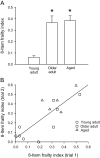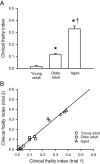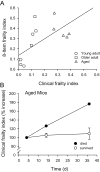A clinical frailty index in aging mice: comparisons with frailty index data in humans
- PMID: 24051346
- PMCID: PMC4022099
- DOI: 10.1093/gerona/glt136
A clinical frailty index in aging mice: comparisons with frailty index data in humans
Abstract
We previously quantified frailty in aged mice with frailty index (FI) that used specialized equipment to measure health parameters. Here we developed a simplified, noninvasive method to quantify frailty through clinical assessment of C57BL/6J mice (5-28 months) and compared the relationship between FI scores and age in mice and humans. FIs calculated with the original performance-based eight-item FI increased from 0.06 ± 0.01 at 5 months to 0.36 ± 0.06 at 19 months and 0.38 ± 0.04 at 28 months (n = 14). By contrast, the increase was graded with a 31-item clinical FI (0.02 ± 0.005 at 5 months; 0.12 ± 0.008 at 19 months; 0.33 ± 0.02 at 28 months; n = 14). FI scores calculated from 70 self-report items from the first wave of the Survey of Health, Ageing and Retirement in Europe were plotted as function of age (n = 30,025 people). The exponential relationship between FI scores and age (normalized to 90% mortality) was similar in mice and humans for the clinical FI but not the eight-item FI. This noninvasive FI based on clinical measures can be used in longitudinal studies to quantify frailty in mice. Unlike the performance-based eight-item mouse FI, the clinical FI exhibits key features of the FI established for use in humans.
Keywords: Deficit accumulation; Deficit index; Frailty index; Senescence..
© The Author 2013. Published by Oxford University Press on behalf of The Gerontological Society of America.
Figures





References
-
- Howlett SE, Rockwood K. New horizons in frailty: ageing and the deficit-scaling problem. Age Ageing. 2013;42:416–423 - PubMed
Publication types
MeSH terms
Grants and funding
LinkOut - more resources
Full Text Sources
Other Literature Sources
Medical

